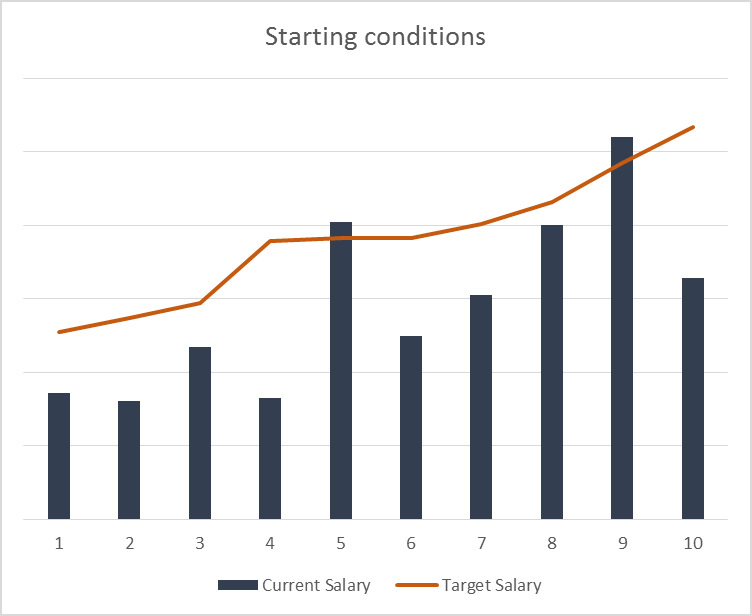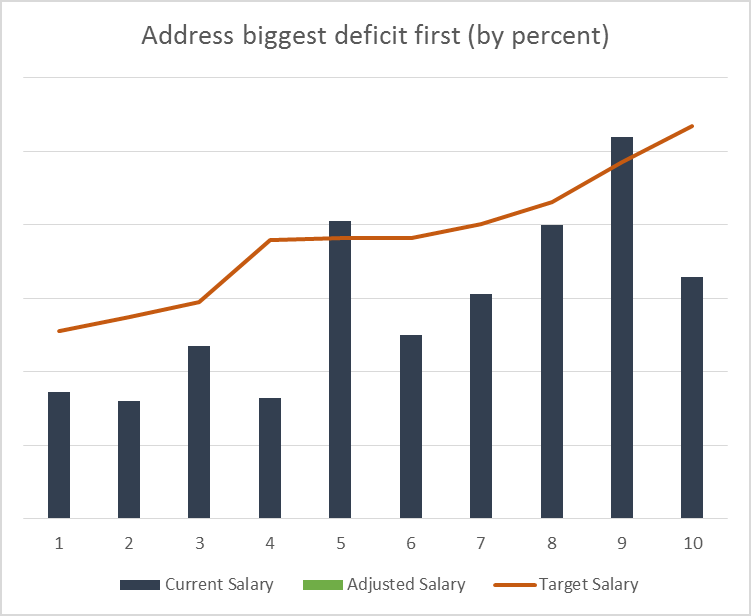The ad hoc Compensation Committee has been working to produce a formula for faculty compensation which I’ll be sharing with you over the next couple of days. We’ll be inviting participation and feedback as we head into next year, when we hope to implement a comprehensive policy with formulas and targets for faculty and staff salaries.
Supposing that all goes off without a hitch, there’s a chance we may have money to allocate to salary increases as early as the middle of next year. I and others have encouraged the college to include salary adjustment money as a continual and growing part of the college’s budget process, the same way we budget for maintenance, computers, subscriptions, and supplies. Under that plan, if approved, we will have some room to make salary adjustments every year *(unless the budget reaches deficit and faces cuts, in which case the pool for salary adjustments might be cut just as any other budget line might).
So, with perhaps unwarranted yet unbridled optimism, a question interesting to me is how we might apply adjustments to existing salaries. The following are in place as starting conditions:
- There will be a formula in place for faculty (and probably staff) salaries based on parameters like length of service and rank
- Most faculty will be below their targets, although possibly not all
- After guaranteeing a living wage for all employees, which is our first priority, the draft compensation philosophy recommends that we address those employees farthest below their targets first.
- Even if above formula targets, no salaries will be reduced as part of this process, although such highly compensated people will likely not get raises for a long while.
Imagine, then, a set of faculty who are mostly below their targets, like this:
As you can see, most faculty are below their targets, although two (#5 and #9) are above. Faculty member #4 seems to be the worst off, while #8 is close to the target.
Here are some models that could be used to get faculty up to their formula-specified targets.
Model #1: Capped flat percent raises
One of the simplest models for salary adjustments is to assign all raises based on a flat overall percentage. Although the methodology for allocation of raises at Guilford in the past has been secret, it seems in many cases to have followed this model for most faculty (likely with additional adjustments for increased rank, positive performance, and other factors).
Imagine if we applied this model, but capped salaries at their formula-specified limits. This would violate our principle of helping those farthest below their targets first, but it would be simple to calculate. I’ve created an animation of how that might look here:
As you can see, faculty member #8 reaches the formula target first, while #4 takes the longest to hit the formula.
This model, while simple, is really the opposite of what we want to do. I don’t think we should follow it, even though flat percent raises are often broadly applied in academia and in the general job market.
Model #2: Help the worst off first
Another approach would be to give raises to those faculty members farthest below their formula targets first. This could be calculated either as a dollar amount or as a percentage, but the percentage approach seems more appropriate. Here’s what that looks like:
As you can see here, application of raises is somewhat spotty, as the worst-off people get helped first. Faculty member #4 gets many raises, including several from the first few phases, while faculty member #8 waits nearly to the end of the process to receive a raise.
Model #3: Proportional adjustments
Finally, here’s another model. This is mathematically more complex, but what it does is assign a pool of raise money to everyone below the formula target based on how far they are from the target. Again, this could be done by dollars or by percent, but I used percentages. It looks like this:
What you see here is that everyone below the formula target grows towards the target and receives a raise every year, but the size of the raise is proportional to the deficit. This also means that everyone reaches their target at about the same time (other than the folks who are already at or above when the process starts).
Conclusion
One caveat – obviously, our formula targets should move upward over time in response to inflation and salary changes at our comparison schools, so these models I’ve made don’t include that factor. It’s not hard to add, though.
I’d be curious what people think of these. Both #2 and #3 above honor the priority to help those worst off first, although #2 does it more literally. I think #3 might generate less confusion and more goodwill, although it is slower to correct the worst problems.
If there are other models or approaches people would like me to animate, let me know and I can do it.





It seems to me that in keeping in-line w/ our philosophy of an equal pay model ,#2 is the fairest option. After all, if those worse off are in fact worse off, doesn’t it make sense to correct those wrongs first? Open here, just thinking that making corrections ( I purposely use the word “corrections” because I feel like it was in error)to the bottom would be a very good way for everyone to feel immediately better about how we allocate salary monies.
I think #3 is the most equitable overall. The incremental changes for the lowest paid are larger but it is more of a “high tides raise all boats” approach. It gives the highest probability of avoiding further salary compression. It also doesn’t penalize anyone nor make folks in the middle tier (who are still not getting much for their years of service in the grand scheme of things) wait years to see salary changes.
As far as new hires vs. helping those already here first and postponing hires- I feel that we should reward folks who have been here, stayed here, and continued to work hard for Guilford. But this would only work if we don’t grow the student population faster than we can complete the compensation adjustments. Otherwise we are, once again, tipping the balance and making folks work harder for less just to keep up.
Pingback:Notes from informal compensation meeting June 17 2016 - The Moon Room
Do these models include contingent faculty? Where do we stand in this whole process? The contract i signed for this semester is paying me less than I earned two years ago and I am doing more work.
As far as I know, the compensation plan for faculty does not include contingent faculty unless they reach full time, in which case I think the thinking now is that full-time non-tenure track faculty will be paid according to the formula in the same way that tenured and tenure-track faculty are. I think that’s not definite yet, though.